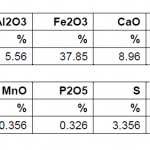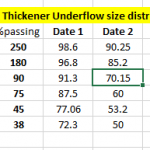- To participate in the 911Metallurgist Forums, be sure to JOIN & LOGIN
- Use Add New Topic to ask a New Question/Discussion about Thickening, Filtering or Tailings and Water.
- OR Select a Topic that Interests you.
- Use Add Reply = to Reply/Participate in a Topic/Discussion (most frequent).
Using Add Reply allows you to Attach Images or PDF files and provide a more complete input. - Use Add Comment = to comment on someone else’s Reply in an already active Topic/Discussion.
Dewatering and water recycling of highly content clay slurries (12 replies and 11 comments)
I suggest you do a Google search on electrokinetic dewatering. I've attached a thesis that should be helpful in providing some background to this technology.
Regards, Adrian
Hi sir,
Thanks for your comment. Actually, I am looking for a industrial type equipment to be used in the plant. Is electrokinetic dewatering being used in industries or it is only under laboratory stage? and what is the cost of such technology ( suppose 100 t/h tailing)? or if there are companies manufacturing such technologies please give the contact info.? Many thanks
Try this link.
It seems it can be done on an industrial scale. I suggest you make contact with people named in the link
Hi,
to do this kind of dewatering on an industrial scale you can also use filterpress.
Depending on the amount of residual moisture you want to achieve this task could be done easily with a recessed plate pack filterpress (please note to use a frame that allows at least 14 bar of pressure avoiding low pressure ones or the residual moisture will be too high) or with a mixed (membrane + recessed) plate pack.
The latter one can be used if the clay content is too high and filtration times gets too long, as in those case you can short the filtration time: anyway in this case you should give priority to higher filtration surface rather than volume (thin cake).
The choice is a balance of cost/benefit. ask capable supplier to help you.
as an example of a large, industrial plant with 100% of very fine clay: https://www.youtube.com/watch?v=tTIYkuZmO-M
Hope it could help!
So many thanks Dear Fabio. I will take this type of method into my consideration along with the cost/benef aspects
you can also get a good dryness by continuous dewatering of the underflow from hydrocyclones in one of our decanter centrifuges http://www.broadbent.co.uk
Dear meller, would you please tell me more about the concept hydrocyclone you said?. You mean we should send the thickener underflow to a hydrocyclone?
hydrocyclones thicken to .20% as our decanters need this feed [ i dont think anything mechanical will deliver 9% wet cake with your PSD.
Sir, do you have any experiences for handling such issue with your decanter? I mean as a reference. And if it is possible please give it your corresponding info. so I can contact you for more. Thanks
Most likely you will need to deslime your tailings stream prior to thickening. Suggest runni9ng a wet PSD (laser should suffice) and use the resulting K80 to size a test-cyclone-system. Ideally, desliming is done before flotation, as it also increases throughput as well, since the fines take up a disproportionate (active) equipment volume. Hope this helps.
Hi Sir,
I appreciate for you time and consideration our problem. Size distribution of tailing was done and it was found that d80 is about 90 micron (if you need i can give the full size distribution) and we also was considering the desliming process. However, we think that the water recycling quantity would not be enough and satisfying. Do you mean to deslime the tailing slurry and send it to say press filter or sth like that? would you please clarify it a lit bit more. Appreciate it
- What are your processing targets, i.e., water recovery from thickening and filtration?
- What is the full PSD of the flow to thickener - feed and underflow?
- What is present % solids of thickener underflow?
Dear Robert;
Tailing goes to thickener. Overflow comes back to plant as process water. We want to recycle the available water in the thickener underflow.
I will attach the PSD of thickener feed in the below. (I think there should not be a difference between thickener underflow and feed PSD, because overflow is pure water. No solid material in overflow
Thickener underflow is about 45-50%, it directly pumps to tailing dam.
If you want to minimise the amount of liquid to be removed from the pulp you can do the test work needed to find the best floc agent to run with your tailings.
The system is based on using an ultra high shear mixing system followed by an in line settling stage followed by a cone settler. It can be run for any rate of pulp throughput on a continuous basis.
In a plant the mixing is done by an inline static mixer with the floc agent being continuously injected into the pulp immediately prior to the mixer.
The flocs form to maximum size and strength within 30 seconds, I usually allow 1 minute to allow for any variables in the floc injection.
This residence time is employed to allow the flocs to form in the pipeline leading from the mixer to the cone settler, entry to the settler is tangential 2/3 up the cone wall. Discharge from the settler is by overflow for the liquor and by continuous bleed discharge for the solids at the bottom of the cone.
Test work for the process requirements is run against Cytec N300 floc agent.
The N300 is mixed up at a rate of 1 gram per litre of water, don't get too enthusiastic on the addition rate as it forms a very sticky mix at higher rates.
500 ml of pulp is acidified to pH 3 in a plastic measuring cylinder, 2 ml of the premixed floc agent is added and with a gloved hand over the open end of the cylinder it is violently shaken for 10 seconds.
The cylinder is then allowed to stand for 1 minute at which time all of the solids are in a layer at the bottom of the cylinder. This test gives you a performance baseline against which other floc agents at various pHs can be compared.
Dear Deano;
Thanks for complete description of your process. I wonder that you are mentioning the changing our flocculant type and mechanism? as we use standard thickener with diameter 30m and low slope angle. I would think that 50% underflow for these types of thickener could be a good result.
Please find the PSD of thickener feed here.
I have also attached the xrd and xrf of tailing material.
Please not that clay minerals currently contains the most of feed and also other sticky materials


So many thanks Friends. Here is PSD of Thickener feed.

The system I detailed is designed to produce an underflow of 60 to 70% solids depending on how fast the tailings solids are discharged.
These solids can be further dewatered by passing them over a vibrating screen deck to the point that the final solids are handled by a bucket loader.
The method is designed to allow ultra high rate flocculation of all solids from a pulp in a fashion where the flocs have very high mechanical strength.
The method is cheaper to run per unit of pulp than a conventional thickener, has a capital cost dramatically lower than a conventional thickener and a very small footprint.
Most flocculant manufacturers have products which will operate well in this type of system.
It is the most efficient dewatering system available for the operating cost.
In my previous plant were i used to work, we installed 4 filter presses for dewatering of tailings, going from 75 % moisture to a 15%, very efficient and reliable equipment I would say.
The company name that installed the equipment is Bilfinger, and the filter presses were designed by Diemme Fitration.
The construction took place in the arctic and took less thatn 1 year.. the climate was very rough that´s why took so long. In normal conditions I could expect 6-7 months of work, or maybe less depending on the tonnage and the number of filterpresses.
Hi Pabloski
Very thanks for your reply. Would you please tell me about the clay minerals content of your tailing?
As per Pabloski's reply, pressure filtration (with membrane squeezing at 12 to 16 bar g) should be able to produce a cake with suitable moisture for dry stacking, say 15 to 18% w/w. Most major equipment suppliers have tailings filtration references and should be able to offer suitable filters and testing services.
High clay content will definitely make filtration more difficult, and in extreme cases impossible, hence the need for test work.
Another issue is potential blinding of the filter cloth, which will further reduce filtration rate over time and shorten the working life of the filter cloth. Filter cloth is usually the biggest operating cost component, not just for the cost of material, but also for the time and labour required to remove old and install new cloths. Cloth blinding should be checked during filtration testing. When selecting the production scale filter, pay attention to cloth washing in the filter and options for removing cloths from the filter to wash externally. Cloth washing should remove embedded particles from the cloth, not simply flush the surface.
Depending on your scale of operation, you could look at the Tube Press that was developed by English China Clays for dewatering kaolin. This operates at up to 150 bar g, but the small size of each unit means that many are required for higher tonnages, which could become a maintenance nightmare.
Hello Dear;
I would thank for your valuable comments on the subject and I personally found it very interesting notes. I will pay attention to those mentioned notes about filter press as so many proposed the filter press option.
agree with Rheomet about desliming, then you can get high specific throughput from filter, but what to do with the slime laden water? What is the driver? is it water scarcity or TSF constraint requiring you to deposit filtered tailings. A bit radical, but possible solution is to develop a HDH (humidification dehumidification) process for separating -20 micron suspension from water and returning a high quality condensate. Capital cost can be managable if you have lots of real estate and sunshine :).....many of our mines (southern hemisphere) have both.

Can someone help me with a problem in tailing filteration?
The fact is that thickener underflow was supposed to go through vacuum disk filter, however, due to highly content of clay minerals, montmorillonite etc, it constantly blocked. So we removed it. I have contacted with some of companies, however, there is no unique equipment for handling such dewatering process. I would appreciate if some one could help me